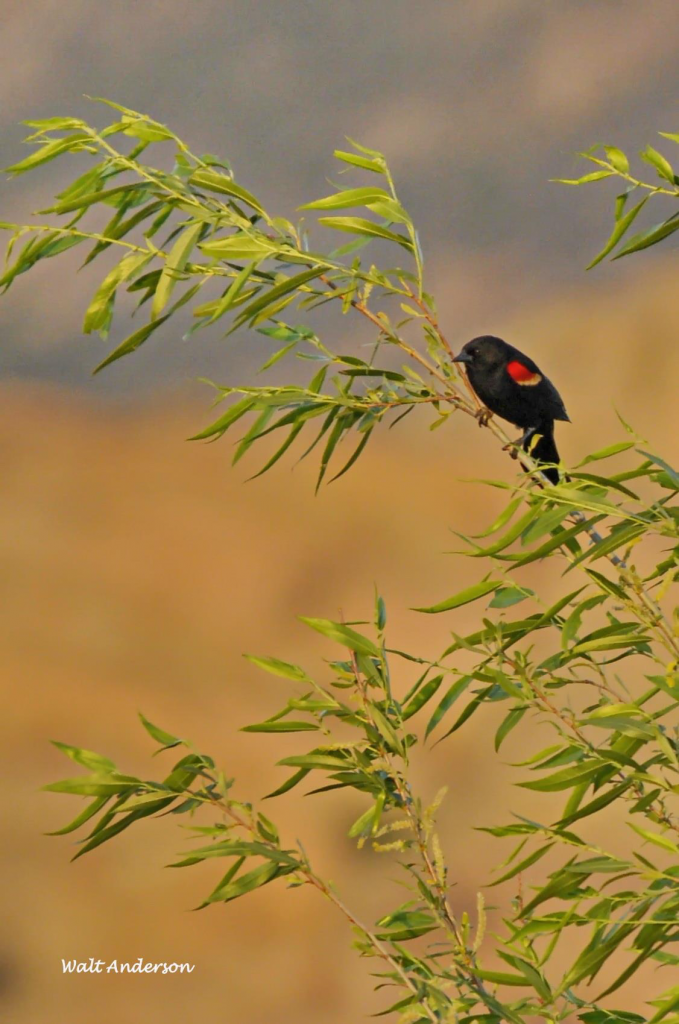Among Friends 10 March 2021, Redwings
by Walt Anderson
A visitor to most Arizona marshes such as at Arivaca Cienega in early March is often greeted with a rich, vibrant chorus of sounds like a warming-up orchestra consisting of violins and flutes but no deep brass. The instrumentalists are indeed warming up, psyching themselves for their upcoming journeys, short or long, to breeding marshes. At this point, the birds are gregarious, and the songs are not threatening, but that will change in a matter of weeks, when communal songfests are replaced by intense vocal and visual displays in defense of territories.
Red-winged Blackbirds are possibly the most abundant birds in North America and probably the most studied of our birds. Just about any graduate student in the country could have easy access to these conspicuous and fascinating birds, and the species’ fame has grown by degrees (Master’s, PhD’s, etc.).

Winter roosts of blackbirds can be enormous—even in the millions! Redwings are often joined by other family members (Icteridae) in these communal roosts and even by unrelated “black birds” like starlings. There’s safety in numbers, both in the roosts and out in the fields where they may feed together, but there is also competition, so if a large roost is used for a lengthy period, foraging flights become longer and longer until there is some sort of avian consensus to move the roost.
●●●

The Red-winged Blackbird male is a real show-off, with colorful red-and-yellow epaulets that contrast with the shiny black body. Breeding birds congregate in productive marshlands (less often in meadows) in a network of territories, with dominant males choosing sites that have the highest quantities of insect food, thereby being most attractive to females looking for good nest sites.
●●●

The lovely “oak-a-lee” songs of males are attractive to females but also are used, along with raising of the wings and flashing of the epaulets, to deter other males. Experiments in which the colorful epaulets were blackened by researchers resulted in the loss of part or all of a male’s territory. If you remove one’s insignias, its rank drops, like a sergeant-major being demoted to corporal (a form of corporal punishment).
●●●

Female Red-winged Blackbirds can be mistaken by novice birders as large, pointy-beaked sparrows. This species is polygynous, meaning that some males with the best territories have multiple mates, while those marginal ones don’t get to breed at all. Females choose to nest in what they perceive as the best male territories, and they maintain smaller anti-female territories of their own with songs that sound like a scolding chatter: “spit-a-chew-chew” (It’s actually prettier than that!). Females do all the nest building and incubating, though their males may help out with some of the childcare if they are not too busy with other harem females.
●●●

When nesting is over, blackbirds molt prior to migrating or dispersing from their breeding territories. Now the birds are chummy again, and sometimes they segregate on their wintering areas by gender. Here is a ladies’ club, no guys allowed.
●●●

In their first summer, yearling males may resemble females or be almost as striking as adult males, but normally they can’t hold territory that first year. This does allow them more time to feed, so they can enter fall and winter with more body fat and better condition than the big daddy males that have been in the thick of mating competition all summer.
●●●

One of the keys to blackbird success is their jaw musculature. Many birds can clamp hard by closing their bills, but blackbirds can spread (gaping) their mandibles with great strength, and that allows them access into corn husks, cattail stalks, and many other places to find invertebrates or seeds. I enjoy gaping at blackbirds.
●●●

During the breeding season, nutritious insect prey are consumed by the hundreds. One study found a blackbird consuming emerging odonates (dragonflies and damselfies like this Northern Bluet) at a rate of about ten per minute. Let’s assume a generous ten-minute break per hour and a ten-hour foraging day—that’s 5000 good-sized insects per day per blackbird! Once again, I caution people to think of the implications of saying that he or she “eats like a bird”!
●●●

Blackbirds flying to their evening roost. Notice the profiles that create a + and – effect; that’s a good way to tell a passing flock from starlings, which flap continuously.
●●●

Don’t wait for the spring flowers to arrive; right now you should get out there in the morning or evening and revel in the wild serenades of the Red-winged Blackbirds! Oak-a-lee!
